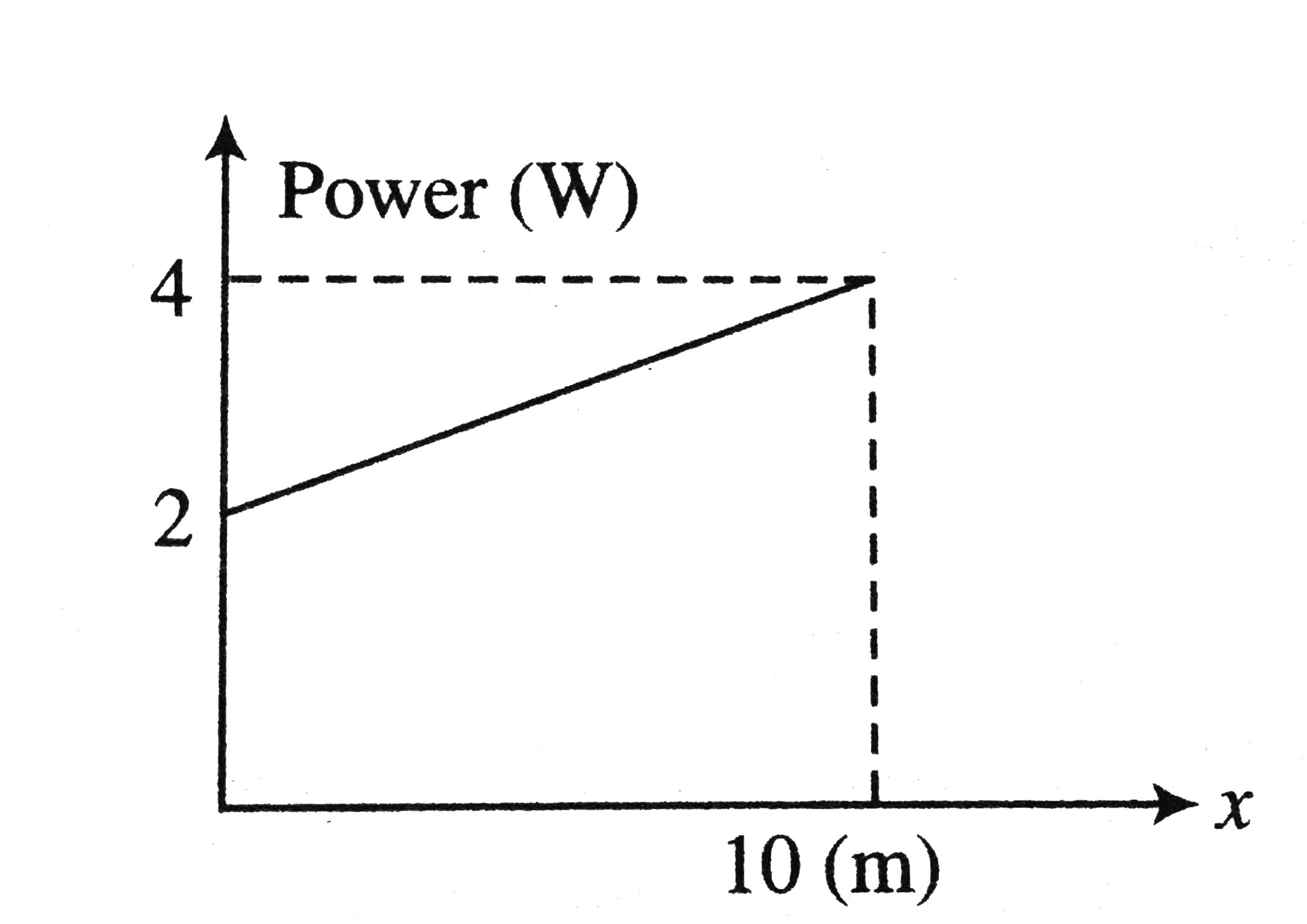A particle of mass 10−2kg is moving along the positive x axis under the influence of a force F(x)=−K/(2x2) where K=10−2Nm2. At time t=0 it is at x=1.0m and its velocity is v=0.
(a) Find its velocity when it reaches x=0.50m.
(b) Find the time at which it reaches x=0.25m.
The correct Answer is:(i) -1m/s (ii) (π3+√34)s
To solve the problem step by step, we will break it down into two parts as requested.
Given Data:
- Mass of the particle, m=10−2kg
- Force acting on the particle, F(x)=−K2x2 where K=10−2Nm2
- Initial position, x0=1.0m
- Initial velocity, v0=0m/s
Part (a): Find the velocity when x=0.50m
1. Using Newton's Second Law:
F=ma=mdvdt=−K2x2
Rearranging gives:
mdvdt=−K2x2
2. Using the chain rule:
dvdt=dvdx⋅dxdt=vdvdx
Therefore, we can write:
mvdvdx=−K2x2
3. Separating variables:
vdv=−K2mdxx2
4. Integrating both sides:
∫vdv=−K2m∫dxx2
This gives:
v22=K2m(1x−1x0)
5. Substituting the limits:
- At x0=1m, v=0
- At x=0.5m, we need to find v.
Thus:
v22=K2m(10.5−1)
6. Calculating K/m:
K=10−2Nm2,m=10−2kg⟹Km=1m2/s2
7. Substituting values:
v22=12(2−1)=12
Therefore:
v2=1⟹v=±1m/s
Since the particle is moving in the negative x-direction:
v=−1m/s
Part (b): Find the time at which it reaches x=0.25m
1. Using the velocity equation derived earlier:
v=−√Km(1−xx0)
2. Substituting x=0.25m:
v=−√1(1−0.251)=−√0.75=−√32m/s
3. Using the relationship v=dxdt:
dt=dxv=dx−√1−xx0
4. Separating variables:
dt=−dx√1−xx0
5. Integrating from x=1 to x=0.25:
t=−∫0.251dx√1−x1
6. Using the substitution x=sin2(θ):
- When x=1, θ=π2
- When x=0.25, θ=π6
7. Integrating:
t=−∫π6π21√1−sin2(θ)⋅2sin(θ)cos(θ)dθ
8. Evaluating the integral:
t=√mK(π3+√34)
Since mK=1:
t=π3+√34s
Final Answers:
(a) The velocity when x=0.50m is v=−1m/s.
(b) The time at which it reaches x=0.25m is t=π3+√34s.
- Mass of the particle, m=10−2kg
- Force acting on the particle, F(x)=−K2x2 where K=10−2Nm2
- Initial position, x0=1.0m
- Initial velocity, v0=0m/s
F=ma=mdvdt=−K2x2
Rearranging gives:
mdvdt=−K2x2
dvdt=dvdx⋅dxdt=vdvdx
Therefore, we can write:
mvdvdx=−K2x2
vdv=−K2mdxx2
∫vdv=−K2m∫dxx2
This gives:
v22=K2m(1x−1x0)
- At x0=1m, v=0
- At x=0.5m, we need to find v.
v22=K2m(10.5−1)
K=10−2Nm2,m=10−2kg⟹Km=1m2/s2
v22=12(2−1)=12
Therefore:
v2=1⟹v=±1m/s
Since the particle is moving in the negative x-direction:
v=−1m/s
v=−√Km(1−xx0)
v=−√1(1−0.251)=−√0.75=−√32m/s
dt=dxv=dx−√1−xx0
dt=−dx√1−xx0
t=−∫0.251dx√1−x1
- When x=1, θ=π2
- When x=0.25, θ=π6
t=−∫π6π21√1−sin2(θ)⋅2sin(θ)cos(θ)dθ
t=√mK(π3+√34)
Since mK=1:
t=π3+√34s
(a) The velocity when x=0.50m is v=−1m/s.
Topper's Solved these Questions
- DYNAMICS OF A PARTICLEBook:VMC MODULES ENGLISHChapter:DYNAMICS OF A PARTICLEExercise:JEE Main (Archive) Level - I
Explore 29 Videos
- DC CIRCUITBook:VMC MODULES ENGLISHChapter:DC CIRCUITExercise:JEE ADVANCED ARCHIVE
Explore 68 Videos
- ELECTROMAGNETIC INDUCTION & ALTERNATING CURRENTBook:VMC MODULES ENGLISHChapter:ELECTROMAGNETIC INDUCTION & ALTERNATING CURRENTExercise:IN-CHAPTER EXERCISE-G
Explore 10 Videos
Similar Questions
A particle moves along the X-axis x=0 to x=5 m under the influence of a force given by F=10−2x+3x2. Work done in the process is
View SolutionA particle moves along the X-axis from x=0 to x=5 m under the influence of a force given by F=7−2x+3x2. Find the work done in the process.
View SolutionA particle moves along X-axis from x=0 to x=1 m under the influence of a force given by F=3x2+2x−10. Work done in the process is
View SolutionA particle moves along X-axis from x=0 to x=1 m under the influence of a force given by F=3x2+2x−10. Work done in the process is
View SolutionA particle A of mass 10/7kg is moving in the positive direction of x-axis. At initial position x=0, its velocity is 1ms−1, then its velocity at x=10m is (use the graph given)

View SolutionA particle A of mass 10/7kg is moving in the positive direction of x−aξs. At initial position x=0, its velocity is 1ms−1, then its velocity at x=10m is (use the graph given)

View SolutionA particle moves along the x-axis from x=0 to x=5m under the influence of a given by F=7−2x+3x2. The work done by the applied force to the particle is.
View SolutionA particle moves along x-axis from x=0 to x=2 m under the influence of a force F (in N) given by F=3x2+2x−5. Calculate the work done
View SolutionTwo particles of masses 1kg and 2kg are located at x=0 and x=3m. Find the position of their centre of mass.
View SolutionTwo particles of masses 1kg and 2kg are located at x=0 and x=3m. Find the position of their centre of mass.
View Solution